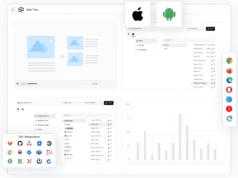
In the competitive and fast-paced world of construction, effective fleet asset management is a linchpin for success. When managed strategically, a construction fleet can significantly enhance a company’s productivity and profitability.
This article will explore the world of fleet asset management within the construction industry, exploring strategies for maximizing returns and demonstrating the paramount importance of proactive, data-driven decision-making.
After reading today’s post, check out Trackunit’s article on IoT, construction and a combination of the two to see how technology can improve your next project.
What is fleet asset management?

Fleet asset management in construction involves the strategic deployment and upkeep of a company’s fleet of vehicles, machinery, and equipment. At its core, it encompasses the following key components:
- Inventory management: This involves accurate tracking of all assets in the fleet, including their specifications, age, condition, and value. An effective inventory management system helps companies avoid unnecessary purchases and identify when replacements or upgrades are necessary.
- Maintenance and repair: Regular and proactive maintenance of fleet assets is essential to avoid downtime and extend the lifespan of the equipment. This includes both routine preventive maintenance and timely repairs when issues arise.
- Utilization tracking: This involves monitoring and analyzing how each asset is being used. Effective tracking can highlight underutilized assets that may be better deployed elsewhere or overused assets that may be at risk of premature wear and tear.
- Lifecycle management: This refers to managing each asset from acquisition to disposal. Effective lifecycle management means making strategic decisions about when to purchase, replace, or retire assets based on factors like cost, utilization, and performance.
- Compliance and safety: Finally, ensuring all fleet assets meet regulatory standards and safety requirements is a critical part of fleet asset management. This can involve regular safety inspections, driver training programs, and staying abreast of changes in relevant legislation.
By effectively managing these components, a construction or equipment rental company can ensure its fleet runs smoothly, operates cost-effectively, and contributes positively to the company’s bottom line.
Incorporating technology into fleet asset management

In the digital era — technology has become a game changer in fleet asset management. Implementing these technologies to your fleet asset management can greatly improve efficiency and maximize returns.
Artificial intelligence (AI) and machine learning (ML)
AI and ML can analyze large amounts of data to predict trends, identify inefficiencies, and suggest improvements. For instance, predictive maintenance technologies leverage AI to forecast equipment failures before they occur, enabling timely interventions and reducing downtime.
Internet of Things (IoT)
IoT devices can offer real-time information on variables like fuel consumption, tire pressure and engine temperature, providing real-time insight that can streamline operations, ensure efficient resource allocation and assist with decisions.
This data can help improve decision-making capabilities while streamlining operations to increase resource utilization and maximize decision-making abilities.
Drones
Drones are often used for inspecting, surveying, and monitoring sites from an aerial view. They can give workers access to inaccessible and hazardous areas, increasing both safety and efficiency at once.
Maximizing returns with fleet asset management

Maximizing returns and improving efficiency in fleet asset management requires a blend of strategic planning, data-driven decision-making and optimized processes. Here are some key strategies construction companies can implement:
- Streamline operations: Streamline your operations by automating repetitive tasks, such as scheduling maintenance, tracking fuel consumption, and generating reports. Automating these tasks not only saves time but also reduces the likelihood of human error.
- Optimize asset utilization: Monitor the usage of each asset closely to identify underutilized or overused equipment. Redistribution of assets can lead to better utilization, minimizing idle time and reducing unnecessary costs.
- Preventive maintenance: Implement a preventive maintenance schedule to avoid unexpected equipment failures and costly downtime. Periodic inspections can also extend your assets’ lifespan, leading to significant cost savings over time.
- Invest in training: Invest in comprehensive training programs for your fleet operators. Properly-trained operators are likely to handle equipment more efficiently and safely, reducing the risk of accidents and premature wear-and-tear on your assets.
- Leverage technology: As mentioned above, utilize the latest technologies such as AI, ML, and IoT to gather real-time data, predict trends, and make informed decisions. These technologies can enhance visibility into your operations and provide valuable insights to optimize performance.
- Lifecycle management: Make strategic decisions about the lifecycle of each asset. Knowing when to replace or retire an asset based on factors such as cost, performance, and utilization can significantly impact your bottom line.
Fleet asset management in construction – final thoughts

In conclusion — effective fleet asset management is a cornerstone of success in the construction industry. The strategic integration of technology and data-driven decision-making can significantly improve efficiency and cost-effectiveness.
Ultimately, the key lies in continuously monitoring, analyzing, and optimizing fleet operations to maximize returns and sustain long-term growth.














